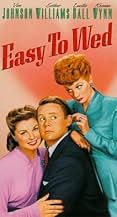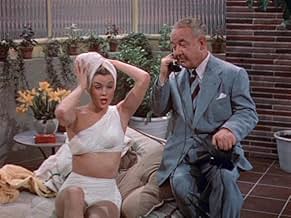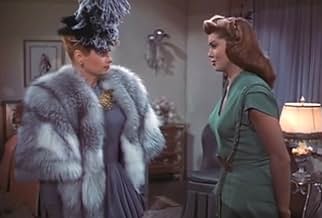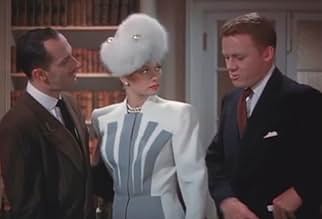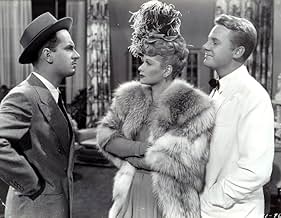Ajouter une intrigue dans votre langueTo prevent a libel case against the paper, a reporter tries to compromise the reputation of a tycoon's slandered daughter.To prevent a libel case against the paper, a reporter tries to compromise the reputation of a tycoon's slandered daughter.To prevent a libel case against the paper, a reporter tries to compromise the reputation of a tycoon's slandered daughter.
- Réalisation
- Scénario
- Casting principal
Carlos Ramírez
- Carlos Ramírez
- (as Carlos Ramirez)
William Bailey
- Newspaper Office Worker
- (non crédité)
Avis à la une
As the other comments here indicate, it's highly instructive to compare LIBELED LADY to this remake, EASY TO WED. A decade brought a huge difference in style between the Thalberg-approved slangy courtship of slapstick repartee and the plush, earnest romance of Louis B. Mayer's MGM of the '40s.
Lucille Ball steals this picture with a very well-judged comic performance, aided by director Edward Buzzell, who clearly throws many scenes her way. What will surprise those who know her primarily from "I Love Lucy" is to see how much of her comic shtick is already on view here, completely developed and intact. The drunk scene, the little voices, the 'takes,' stares, reactions and expressions are familiar in every way as Lucy Ricardo. Ball also never looked more beautiful than in this film, with her hair as metallic and bright as a new penny, and in a series of witty and gorgeous costumes by Irene, who does just as well by Esther Williams.
But those who are critical of Ball's performance, particularly in contrast to Jean Harlow's in LIBELED LADY, are right. Harlow was a natural, a wonderful, winning and unique personality, whose blustering scenes of anger were always justified, always expressing her common sense and dignity. The dirty little secret about why Lucille Ball never made it as a movie star was that despite her professionalism and beauty, she was essentially a strident and cold personality. What Harlow did naturally, Ball works very hard to achieve so that we admire her pyrotechnics without ever warming up to her. By the time of "I Love Lucy" she had begun to disguise her intensity with clutziness and feigned vulnerability and stupidity. And like Katharine Hepburn, she learned that if Lucy was reined-in by a man once in a while, audiences could forgive her for her aggressiveness.
There is relatively little of Esther Williams' swimming in this picture. At this mid-'40s point, MGM was pushing her versatility to see just how much she could do, how far she could go. I happen to think that her screen presence (even when out of the water) is underrated. She had a refreshing, no-nonsense self confidence that is very American, and she was sexy in a way that is never blatant. The fact that this statuesque beauty with her strong physical presence and perfect carriage never acts seductively or coyly creates an unexpected sexual tension, especially in her early films (she lost a bit of it later as her body became thicker and more athletic). You can see how some would feel moved to ruffle her composure, warm her up, 'get' to her in some way, because she seems oblivious to her femininity while brimming over with it. Which is what makes her seem an emblematic American movie star. In the first half of this picture she gives a good account of the kind of frigid glamor girl that Alexis Smith often played at Warners.' When she finally melts, it's lovely, though she is better photographed in both THRILL OF A ROMANCE and THIS TIME FOR KEEPS (where she rates closeups by Karl Freund that make her look almost impossibly, lustrously beautiful).
A word about MGM's '40s Technicolor -- I love it. Many films from this period as screened on TCM seem to have been saved, restored, remastered for video tapes and DVDs. All of Esther Williams' color films from the mid-'40s are a visual treat with bright, deeply saturated color and sharp images, though a few scenes in EASY TO WED seem unaccountably muddy and soft, with desaturated color. And in one scene Ball wears a frosty blue costume that we have been told is green. Maybe they should take a look at this print before they put this film out on DVD.
Lucille Ball steals this picture with a very well-judged comic performance, aided by director Edward Buzzell, who clearly throws many scenes her way. What will surprise those who know her primarily from "I Love Lucy" is to see how much of her comic shtick is already on view here, completely developed and intact. The drunk scene, the little voices, the 'takes,' stares, reactions and expressions are familiar in every way as Lucy Ricardo. Ball also never looked more beautiful than in this film, with her hair as metallic and bright as a new penny, and in a series of witty and gorgeous costumes by Irene, who does just as well by Esther Williams.
But those who are critical of Ball's performance, particularly in contrast to Jean Harlow's in LIBELED LADY, are right. Harlow was a natural, a wonderful, winning and unique personality, whose blustering scenes of anger were always justified, always expressing her common sense and dignity. The dirty little secret about why Lucille Ball never made it as a movie star was that despite her professionalism and beauty, she was essentially a strident and cold personality. What Harlow did naturally, Ball works very hard to achieve so that we admire her pyrotechnics without ever warming up to her. By the time of "I Love Lucy" she had begun to disguise her intensity with clutziness and feigned vulnerability and stupidity. And like Katharine Hepburn, she learned that if Lucy was reined-in by a man once in a while, audiences could forgive her for her aggressiveness.
There is relatively little of Esther Williams' swimming in this picture. At this mid-'40s point, MGM was pushing her versatility to see just how much she could do, how far she could go. I happen to think that her screen presence (even when out of the water) is underrated. She had a refreshing, no-nonsense self confidence that is very American, and she was sexy in a way that is never blatant. The fact that this statuesque beauty with her strong physical presence and perfect carriage never acts seductively or coyly creates an unexpected sexual tension, especially in her early films (she lost a bit of it later as her body became thicker and more athletic). You can see how some would feel moved to ruffle her composure, warm her up, 'get' to her in some way, because she seems oblivious to her femininity while brimming over with it. Which is what makes her seem an emblematic American movie star. In the first half of this picture she gives a good account of the kind of frigid glamor girl that Alexis Smith often played at Warners.' When she finally melts, it's lovely, though she is better photographed in both THRILL OF A ROMANCE and THIS TIME FOR KEEPS (where she rates closeups by Karl Freund that make her look almost impossibly, lustrously beautiful).
A word about MGM's '40s Technicolor -- I love it. Many films from this period as screened on TCM seem to have been saved, restored, remastered for video tapes and DVDs. All of Esther Williams' color films from the mid-'40s are a visual treat with bright, deeply saturated color and sharp images, though a few scenes in EASY TO WED seem unaccountably muddy and soft, with desaturated color. And in one scene Ball wears a frosty blue costume that we have been told is green. Maybe they should take a look at this print before they put this film out on DVD.
This is one of the few times at MGM Lucy was given a chance to exploit her full comedic range, and she goes at it with gusto. From the moment she makes her whirlwind entrance looking absolutely gorgeous in a white wedding gown, she commands the screen whenever the camera is on her. In fact, though the movie ostensibly "stars" Van Johnson and Esther Williams, the bland leads take a back seat to the lively pairing of Lucy and Keenan Wynn, as her somewhat morally corrupt boyfriend. Forget comparisons to "Libeled Lady"; "Easy to Wed" is of a different era, and much more slapsticky, and, as noted, Lucy is a gem whether getting drunk and playing the piano or evincing true pathos as a wronged woman. She has rarely been photographed more appealingly, either.
Musical remake of "Libeled Lady" doesn't come close to matching the 1936 screwball classic but is mildly entertaining. Williams, Johnson, Ball, and Wynn are no match for the stellar cast of Myrna Loy, William Powell, Jean Harlow, and Spencer Tracy. Johnson and Williams are too bland in the lead roles. Lucy provides a few chuckles; upon learning that Johnson may be married to two women, she says, "That's arson." The funniest scene has her getting drunk with Johnson. Williams gets a dip in the pool but the musical numbers are not memorable and probably contribute to the lethargic pacing. By comparison, the original zipped along at a rapid pace.
Lucy obviously had her talents (though I'm not much of a fan of her television stuff) and she has a few good scenes here. But watching her do the big blow up speech at the end word for word the same as Jean Harlow, we see she had nowhere near the talent as Harlow. Harlow did that scene with such humanity and timing. This had none of that.
I almost never see the reason for remakes, very few are anywhere near as good as the original and this is a great example. Watch the original, much better.
I almost never see the reason for remakes, very few are anywhere near as good as the original and this is a great example. Watch the original, much better.
Keenan Wynn's newspaper has been a political opponent of Cecil Kellaway for years. So when they publish an actionable story about his daughter, Esther Williams being a man-stealer, Kellaway wastes no time filing a lawsuit. The solution is to get womanizing Van Johnson to seduce her.... and to marry him to Wynn's fiancee, Lucille Ball, to make the first story retroactively true.
It's a remake of LIBELED LADY, with a few musical numbers and a swimming pool for Esther Williams to potsker around in. It's directed more as a straight farce than the original, and that part works all right; given that the original cast was Spencer Tracy, William Powell, Myrna Loy and Jean Harlow, it's hard for any of these to come up to snuff, although Miss Ball is very good. Johnson gives the impression of a small boy playing dress-up, and Keenan Wynn seems to think the movie is a lot funnier than it is.
It's a remake of LIBELED LADY, with a few musical numbers and a swimming pool for Esther Williams to potsker around in. It's directed more as a straight farce than the original, and that part works all right; given that the original cast was Spencer Tracy, William Powell, Myrna Loy and Jean Harlow, it's hard for any of these to come up to snuff, although Miss Ball is very good. Johnson gives the impression of a small boy playing dress-up, and Keenan Wynn seems to think the movie is a lot funnier than it is.
Le saviez-vous
- AnecdotesA remake of one of the great comedies of the 1930s - Une fine mouche (1936) with Jean Harlow, William Powell, Myrna Loy, and Spencer Tracy.
- Citations
William Stevens 'Bill' Chandler: You're too modest. Why, you're a woman of great depths, depths that have never been plumbed.
Gladys Benton: [referring to her boyfriend] No, Warren's not much of a plumber.
- ConnexionsFeatured in Lucy and Desi: A Home Movie (1993)
- Bandes originalesContinental Polka
Lyrics by Ralph Blane
Music by Johnny Green
Sung and Danced by Lucille Ball (dubbed by Virginia Rees) and chorus
Meilleurs choix
Connectez-vous pour évaluer et suivre la liste de favoris afin de recevoir des recommandations personnalisées
- How long is Easy to Wed?Alimenté par Alexa
Détails
Box-office
- Budget
- 1 683 000 $US (estimé)
- Durée1 heure 50 minutes
- Rapport de forme
- 1.37 : 1
Contribuer à cette page
Suggérer une modification ou ajouter du contenu manquant



